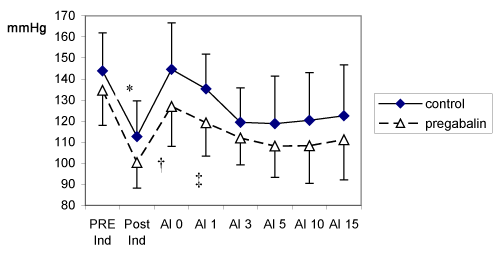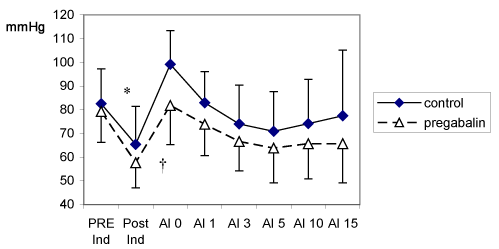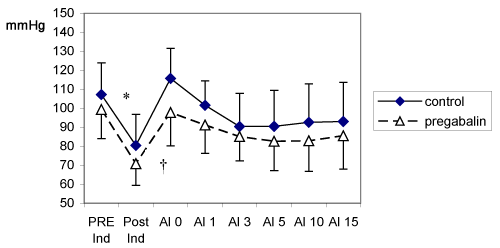| Research Article |
Open Access |
|
| Ebru Salman*, Çaßatay Çelik and Selim Candan |
| Baskent University Faculty of Medicine, Department of Anesthesiology and Reanimation, Ankara, Turkey |
| *Corresponding authors: |
Dr.A.Ebru Salman
Baskent University Faculty of Medicine
Department of Anesthesiology and Reanimation
Bahçelievler TR- 06490 Ankara, Turkey
Tel:+90 533 629 98 67, +90 312 241 63 52
E-mail: ebru.salman@gmail.com |
|
| |
| Received June 07, 2012; Published August 23, 2012 |
| |
| Citation: Salman E, Çelik Ç, Candan S (2012) Premedication with Single Dose Pregabalñn 150 Mg Attenuates Hemodynamic Response to Laryngoscopy and Endotracheal Intubatñon. 1:297. doi:10.4172/scientificreports.297 |
| |
| Copyright: © 2012 Salman E, et al. This is an open-access article distributed under the terms of the Creative Commons Attribution License, which permits unrestricted use, distribution, and reproduction in any medium, provided the original author and source are credited. |
| |
| Abstract |
| |
| Purpose: Laryngoscopy and intubation may cause undesirable increases in blood pressure and heart rate. The aim of the present study was to investigate the effect of pregabalin premedication on the hemodynamic responses to laryngoscopy and intubation. |
| |
| Methods: Sixty ASA phsical status I or II patients undergoing elective surgery under general anesthesia were randomly allocated into two groups who received either pregabalin 150 mg or placebo 1 hour prior to surgery. Systolic, Diastolic, Mean arterial blood pressures and Heart rate were recorded before and after anesthesia induction and 0,1,3,5,10 and 15 minutes after tracheal intubation. |
| |
| Results: Demographic data and base-line values for Systolic, Mean, Diastolic arterial blood pressures and Heart rate values were similar between groups. SAP was significantly lower in the pregabalin than in the control group after anesthesia induction, at intubation and one minute postintubation. Heart rate did not differ between groups at all time points. |
| |
| Conclusion: In the present study design, oral pregabalin premedication at a dose of 150 mg one hour prior to surgery attenuates early hemodynamic changes associated with laryngoscopy and endotracheal intubation. |
| |
| Keywords |
| |
| Pregabalin; Intubation; Haemodynamia |
| |
| Introduction |
| |
| Laryngoscopy and intubation are associated with several unwanted hemodynamic responses such as hypertension, tachycardia, arrhytmias, and increased circulating catecholamines [1]. |
| |
| Hypertension and tachycardia are two dynamic predictors of perioperative cardiac morbidity, so prevention of these responses to laryngoscopy and intubation remains an important clinical goal particularly for the patients with cardiac or cerebral disease. |
| |
| Several methods have been used to attenuate the hemodynamic responses to laryngoscopy and intubation such as pretreatment with beta blockers, calcium channel blockers, opioids, and nitroglycerin, bolus dose of sufentanil, remifentanil, dexmedetomidine, oropharyngeal lidocaine instillation [1-4]. |
| |
| The most recent studies aimming attenuating hemodynamic response to laryngoscopy and intubation focused on the effect of gabapentin [1,5,6]. |
| |
| Pregabalin, like gabapentin is a novel drug that has analgesic, anticonvulsant and anxiolytic effects [7,8]. It is mainly used for the treatment of neuropathic pain, postherpetic neuralgia and as adjunctive therapy in patients with partial onset seizures [9,10]. The efficacy of oral pregabalin on postoperative analgesia and reduction of parenteral analgesics has been demonstrated in several studies [11-13]. |
| |
| Only few data is present in literature relating the cardiovascular properties of pregabalin on the patients undergoing surgery [14,15]. The aim of the present study was to investigate the effect of pregabalin on the changes in blood pressure and heart rate changes observed during laryngoscopy and endotracheal intubation. |
| |
| Methods |
| |
| After obtaining approval of Instutional Ethic commitee (BASKENT University, Turkey) and written informed consent of patients , 60 normotensive ASA physical status I or II, aged 18-55 years ,undergoing elective surgery lasting 1-3 hours were devided into two groups of 30 each. The exclusion criteria included the known allergy or contraindication to anesthetics or study drugs, anticipated difficult intubation, pregnancy, history of alcohol abuse, chronic pain, daily intake of analgesics and corticosteroids, diabetes, asthma and renal insufficiency. Patients were randomly allocated according to computer generated randomization. Control group patients, group C received oral placebo (n=30) and pregabalin group, group P(n=30) received pregabalin 150 mg capsule (Pfizer,Godecke GmbH, Germany) 1 hour prior to surgery. The study drugs were prepared by pharmacy and appropriate code number was assigned. Group allocation was done by an anesthesiologist who was not aware of the study protocol and did not participate in the study. In the operating room standard monitoring, consisting of ECG, pulse oximetry, non-invasive blood pressure was used. A 20 G cannula was inserted in a peripheral vein, and lactated Ringer’s solution was started. Patients were not premedicated. Anesthesia was induced with propofol 2 mg/kg and fentanyl 1 mcg/ kg and 0.1 mg/kg vecuronium bromide to fascillitate endotracheal entubation. Anesthesia was maintained with 1 MAC isoflurane with a fresh gas flow 3 L/min (50% O2 in N2O). Mechanical ventilation was adjusted to maintain normocarbia. Laryngoscopy and tracheal intubation were performed 2.5 min after vecuronium application by an experienced anesthesiologist using Macintosh 3 laryngoscope blade and 7.0-8.0 mm endotracheal tube (for women and men respectively) on the first attempt. Systolic, diastolic and mean arterial blood pressure(SAP, DAP, MAP) and heart rate(HR) were recorded before and after administration of i.v anesthetics, immediately after intubation and cuff inflation, and 1, 3, 5, 10, 15 min after. The duration of laryngoscopy and intubation was limited to minimum possible time and being similar to all patients. MAP<50 mmHg was considered as hypotension and HR<50 beat was considered as indicator of bradycardia. Bradycardia was treated with atropin and hypotension was treated with ephedrine. After tracheal extubation the patients were questioned 24 hours after by an anesthesiologist who was not enrolled into the study about the occurence of any side effects, such as nausea, vomiting, diarrhea, dizziness, peripheral oedema and headache and recorded if they were present. |
| |
| Statistical Analysis |
| |
| Patient’s charactersitics between the two groups were compared with Student’s t test for unpaired observations ANOVA with repeated measures was used to compare the changes in SAP, DAP, MAP and HR values. P<0.05 was considered as statistically significant. Statistical package SPSS 10.0 (SPSS Inc.,Chicago,IL) Power calculations suggested that a minimum 20 patients per group would detect a 15% difference in SAP or HR between two groups. (alpha =0.05, beta=0.2) The primary aim of this study was to compare by means of differences in SAP and HR during follow up interval between groups. A sample size of 20 per group was required to detect at least 15% difference in SAP (SD: 31.6, mean difference: 18.1 mmHg) and HR (SD: 21.7, mean difference: 11.2 beat/min) with a power of 80% at the 5% significance level. The difference of 15% was taken from both pilot study and clinical experience. Sample size estimation was performed by using NCSS and PASS 20001 software. |
| |
| Results |
| |
| Patient characteristics were similar between the groups. The patients in the two groups were similar in ASA classification, gender, age ,weight, height, and duration of anaesthesia. (Table 1) The duration of laryngoscopy and intubation was similar in all patients. HR did not differ between groups at this time interval (Figure 1). Base-line values for SAP, DAP ,MAP and HR were comparable between groups.(Figure 1,2,3,4) After anesthesia induction, SAP, DAP, MAP were significantly lower in the pregabalin group (p=0.002, 0.031, 0.011) respectively. (Figure 2,3,4). HR did not differ with regard to group. Values of SAP, DAP, MAP were also significantly different in the pregabalin group (p=0.02,p<0.001,p<0.001) respectively at intubation.(Figure 2,3,4). At one minute post-intubation, SAP was significantly lower in the pregabalin group (p<0.001). |
| |
|
|
Table 1: Demographical Data. |
|
| |
|
|
Figure 1: Mean heart rate (±1 standard deviation) of control and pregabalin groups, there were no statistically significant difference between groups (p>0.05). |
|
| |
|
|
Figure 2: Mean systolic blood pressure (±1 standard deviation) of control and pregabalin groups, *: the difference in Post Ind. between groups was found statistically significant (p=0.002), †: the difference in AI 0 between groups was found statistically significant (p=0.020), ‡: the difference in AI 1 between groups was found statistically significant (p<0.001). |
|
| |
|
|
Figure 3: Mean diastolic blood pressure (±1 standard deviation) of control and pregabalin groups, *: the difference in Post Ind. between groups was found statistically significant (p=0.031), †: the difference in AI 0 between groups was found statistically significant (p<0.001). |
|
| |
|
|
Figure 4: Mean blood pressure (±1 standard deviation) of control and pregabalin groups, *: the difference in Post Ind. between groups was found statistically significant (p=0.011), †: the difference in AI 0 between groups was found statistically significant (p<0.001). |
|
| |
| During study period no patient developed cardiac arrhytmias, ischeamic changes in ECG, bronchospasm, wheezing or desaturation. We did not use ephedrine or atropine. We did not see any side effect, such as nausea, vomiting, respiratory depression, peripheral oedema and headache and somnolance in any of the patients. |
| |
| Discussion |
| |
| Laryngoscopy and intubation are associated with cardiovascular changes such as hypertension, tachycardia and dysrhythmias [1]. The reduction in tachycardia, hypertension and sympathic activity should be of benefit in patients of myocardial ischemia [3]. Shribman et al. showed that laryngoscopy alone or laryngoscopy with endotracheal intubation increases arterial blood pressure and catecholamine levels, while intubation especially increases heart rate [16]. |
| |
| Attenuation of the sympathoadrenal stress response is an important goal especially in high risk patients. Several methods have been used to attenuate hemodynamic responses following laryngoscopy and intubation. Topical and systemic lidocaine, alpha or beta adrenergic blockers, opioids, dexmedetomidine have been used with various success [3,5,17]. Intranasal nitroglycerin attenuated the hypertensive response to laryngoscopy and endotracheal intubation but tachycardia was observed in both the nitroglycerin and the control group [18]. Remifentanil bolus at a dose of 1mcg/kg followed by 0.5 mcg/kg/min attenuated the pressor response to intubation but was associated with bradycardia or hypotension [19]. |
| |
| In this study, it was shown that oral premedication with pregabalin 150 mg one hour before surgery attenuated the hemodynamic response to laryngoscopy and endotracheal intubation. It might be due to adequate analgesia and sedation. The effect of pregabalin on the hemodynamic response to laryngoscopy and tracheal intubation might be explained by its inhibitory effects on membrane voltage gated calcium channels. Pregabalin, binds potently and selectively to the alpha 2 delta subunit of hyperexcited voltage gated calcium channels. It modulates the release of excitatory neurotransmitters in hyperexcited neurons, restoring them to normal physiologic state, by reducing calcium influx at nerve terminals [10]. A possible effect of pregabalin on heart rate may have been covered by propofol and fentanil in both groups. Propofol, producing bradycardia and hypotension may partly compansate the cardiovascular changes and tachycardia related to laryngoscopy and endotracheal intubation in both groups. |
| |
| Pregabalin has a linear pharmacokinetic profile with a time to peak plasma concentration up to 1 hour, and oral bioavailability of 90%. It is only slightly metabolized by liver, and up to 98% of administered dose is eliminated unchanged by kidneys.(20) Since pregabalin does not undergo hepatic metabolism, it is unlikely that hepatic enzyme inducing or inhibiting drugs would alter its pharmacokinetics [9]. |
| |
| Pregabalin is recently used as an adjuvant for high quality acute postoperative pain control. A multimodal approach has been suggested to improve postoperative analgesia and to reduce opioid related side effects [20]. Mathiesen et al. demonstrated that single preoperative dose of pregabalin 300 mg resulted in approximately 50% reduction in 24 hr morphine requirements in patients undergoing hip surgery [21]. In another study, perioperative pregabalin administration is associated with less pain intensity and better functional outcomes 3 months after lumbar disc surgery [22]. Therefore, its pharmacologic, analgesic and anxiolyitic properties make it a useful drug for premedication [23]. |
| |
| White and coalleagues indicated that preoperative medication with pregabalin at doses 75 to 300 mg was not effective in attenuating acute preoperative anxiety, on the other hand pregabalin at the dose of 300 mg produced increased level of sedation before and after ambulatory surgery [24]. Based on the result of this study, dose of pregabalin was chosen as 150 mg. In this study only healty patients aged 18-55 years were evaluated. This study group may not reflect the clinical circumstances on many occasions. Sedation was not scored in the present study. This can be considered as a limitation of our study. Another drawback of our study is that we did not measure the level of stress hormones. |
| |
| Further studies are required in order to show dose-response relationship, optimal dosing in different study populations in order to see the clinical relevance of this effect. |
| |
| In conclusion, pregabalin premedication at a dose of 150 mg attenuated the hemodynamic response associated with laryngoscopy and endotracheal intubation. |
| |
| |
| References |
| |
- Fassoulaki A, Melemeni A, Paraskeva A, Petropoulas G (2006) Gabapentin attenuates the pressor response to direct laryngoscopy and tracheal intubation. Br J of Anaesth 96: 769-773.
- Liao X, Yang QY, Xue FS, Luo MP, Xu YC, et al. (2009) Bolus dose remifentanil and sufentanil blunting cardiovascular intubation responses in children:a randomized, double blind comparison. Eur J Anesthesiol 26: 73-80.
- Basar H, Akpinar S,Doganci N, Büyükkoçak U, Kaymak Ç , et al. (2008) The effects of preanesthetic, single dose dexmedetomidine on induction, hemodynamic, and cardiovascular parameters. J of Clin Anesth 20: 431-436.
- Sun HL, Wu TJ, Ng C, Chien C, Chie W, et al. (2009) Efficacy of oropharyngeal lidocaine instillation on hemodynamic responses to orotracheal entubation. J of Clin Anaesth 21:103-107.
- Kaya F.N, Yavasçaoglu B, Baykara M, Altun G.T, Gülhan N, et al. (2008) Effect of oral gabapentin on the intraocular pressure and haemodynamic responses induced by tracheal intubation. Acta Anaesthesiol Scand 52: 1076-1080.
- Memis D,Turan A, Karamanlioglu B, Seker S, Türe M (2006) Gabapentin reduces cardiovascular responses to laryngoscopy and tracheal entubation.Eur J of Anesth 23: 686-690.
- Tiippana EM, Hamunen K, Kontinen VK, Kalso E (2007) Do surgical patients benefit from perioperative Gabapentin/Pregabalin? A systematic review of efficacy and safety.Anesth Analg 104: 1545-1556.
- Rose MA, Kam CA (2002) Gabapentin: Pharmacology and its use in pain management. Anaesthesia 57: 451-462.
- Shneker BF, McAuley JW (2005) Pregabalin: A neuromodulator with broad theurapatic indications .The Ann of Pharmacol 39: 2029-2037.
- Kavoussi R (2006) Pregabalin:From molecule to medicine. Eur Neuropschycopharmacol 16: 128-133.
- Ghai A, Gupta M, Hooda S, Singla D, Wadhera R (2011) Arandomized controlled trial to compare pregabalin with gabapentin for postoperative pain in abdominal hysterectomy.Saudi J Anaesth 5: 252-257.
- Kohli M, Murali T, Gupta R, Khan P, Bogra J (2011) Optimization of subarachnoid block by oral pregabalin for hysterectomy. J Anaesthesiol Clin Pharmacol 27:101-105.
- Durkin B, Page C, Glass P (2010) Pregabalin fort he treatment of postsurgical pain.Expert Opin Pharmacother 11: 2751-2758.
- Eren G, Kozanhan B, Hergunsel O (2009) Pregabalin Blunts Cardiovascular Responses To Laryngoscopy And Tracheal Intubation. J Anesthesiol Reanim 7: 82-87.
- Sundar AS, Kodali R, Sulaiman S, Ravullapalli H, Karthekeyan R, et al. (2012) The effects of preemptive pregabalin on attenuation of stress response to endotracheal intubation and opioid- sparing effect in patients undergoing off-pump coronary artery bypass grafting.Ann Car Anaesth 15:18-25.
- Shribman AJ, Smith G,Achola KJ (1987) Cardiovascular and cathecolamine responses to laryngoscopy with and without tracheal entubation. Br J Anaesth 59: 295-299.
- Ugur B, Ogurlu M, Gezer E, Aydin ON, Gürsoy F (2007) Effects of esmolol, lidocaine and fentanyl on haemodynamic responses to endotracheal entubation.A comparative study.Clin Drug Invest 27: 269-277.
- Fassoulaki A, Kaniaris P (1983) Intranasal administration of nitroglycerin attenuates the presor response to laryngoscopy and intubation of the trachea. Br J Anesth 55: 49-52.
- Thompson JP, Hall AP,Russell J,Cagney B, Rowbotham DJ (1998) Effect of remifentanil on the hemodynamic response to orotracheal entubation. Br J Anaesth 80: 467-469.
- Jokela R, Ahonen J, Tallgren M, Haanpaa M,Korttila K (2008) Premedication with pregabalin 75 or 150 mg with ibuprofen to control pain after day case gynaecological laparascopic surgery. Br J Anaesth 100: 834-840.
- Mathiesen O, Jacobsen LS, Holm HE, Randall S, Adamiec –Malmstroem L, et al. (2008) Pregabalin and dexamethasone for postoperative pain control: a randomized controlled study in hip arthoplasty. Br J Anaesth 101: 535-541.
- Burke SM, Shorten GD (2010) Perioperative pregabalin administration improves pain and functional outcomes 3 months after lumbar discectomy.Anesth Analg 110:1180-1185.
- Gupta K, Sharma D, Gupta PK (2011) Oral premedication with pregabalin or clonidine for hemodynamic stability during laryngoscopy and laparoscopic cholecystectomy: A comperative evaluation. Saudi J Anaesth 5: 179-184.
- White PF, Tufanogullari B, Taylor J, Klein K (2009)The effect of pregabalin on preoperative anxiety and sedation levels:a dose ranging study.Anesth Analg 108: 1140-1145.
|
| |
| |




